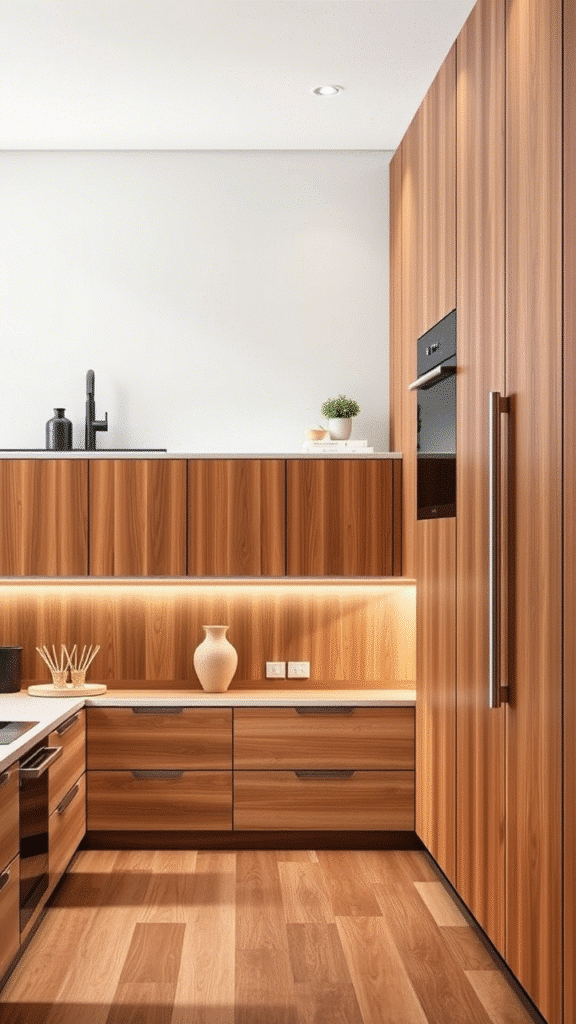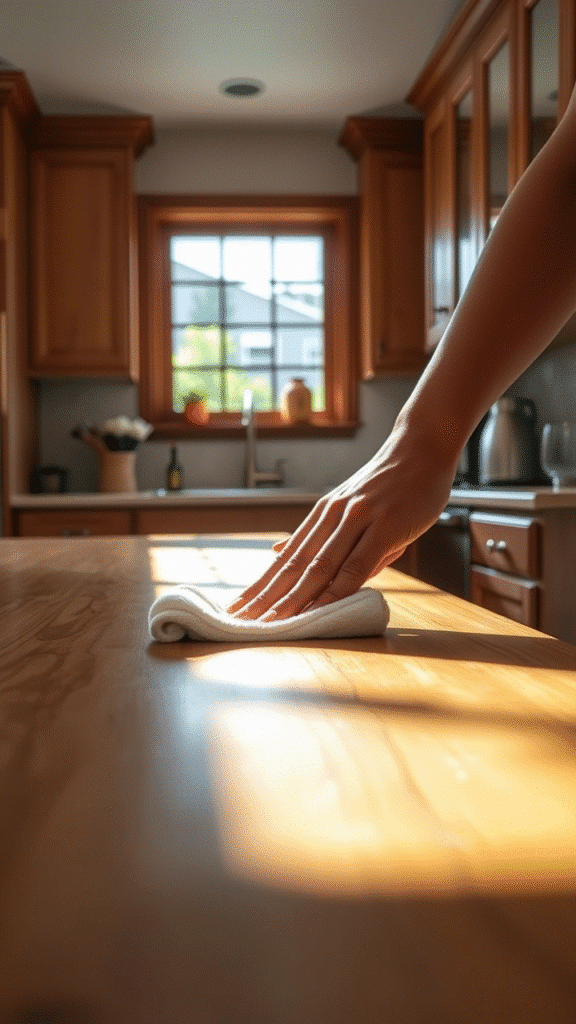Wooden kitchens are more than just a trend—they’re a timeless blend of warmth, durability, and natural beauty. Whether you’re renovating an existing space or designing a new one, incorporating wood elements can transform your kitchen into a welcoming and functional hub. This comprehensive guide explores the multifaceted world of wood kitchen design, offering insights into sustainable choices, material pairings, color palettes, layouts, storage solutions, lighting strategies, and maintenance tips.
1. Sustainable Choices: Eco-Friendly Wood Selections
In an era where sustainability is paramount, choosing eco-friendly materials for your kitchen is both a responsible and stylish decision.
♻️ Why Sustainability Matters
Opting for responsibly sourced wood helps preserve forests, reduces carbon footprints, and supports ethical forestry practices. Certifications like the Forest Stewardship Council (FSC) ensure that the wood used comes from well-managed forests that provide environmental, social, and economic benefits.
🌱 Eco-Friendly Wood Options
- Reclaimed Wood: Sourced from old buildings, barns, or warehouses, reclaimed wood adds character and history to your kitchen while reducing the demand for new timber.
- Bamboo: A fast-growing grass, bamboo is a renewable resource that offers durability and a sleek, modern aesthetic.
- Cork: Harvested from the bark of cork oak trees without harming the tree itself, cork is a sustainable and unique material for kitchen elements.
- Certified Hardwoods: Woods like maple, oak, and walnut can be sourced sustainably, ensuring minimal environmental impact.
🌍 Benefits of Sustainable Wood Kitchens
- Reduced Carbon Footprint: Sustainable sourcing practices help mitigate climate change by reducing deforestation and promoting carbon sequestration.
- Durability and Longevity: High-quality, responsibly sourced wood tends to be more durable, ensuring your kitchen lasts for generations.
- Aesthetic Appeal: Sustainable woods often have unique grains and colors, adding a distinctive charm to your kitchen design.
2. Harmonizing Materials: Blending Wood with Other Elements
A successful wood kitchen design often involves balancing wood with other materials to create a cohesive and dynamic space. The interplay between different textures and finishes can elevate the overall aesthetic and functionality of your kitchen.
🔄 Pairing Wood with Other Materials
- Stone Countertops: Marble or quartz surfaces contrast beautifully with wood tones, adding depth and sophistication to your kitchen.
- Matte Black Hardware: Sleek, matte black fixtures provide a modern touch that complements the warmth of wood.
- Glass Inserts: Incorporating glass panels in cabinet doors lightens the look and allows for display of decorative items.
- Subway Tile Backsplash: A classic choice that offers a neutral backdrop, allowing wood elements to stand out.
🧩 Creating Balance
When combining materials, aim for balance in both color and texture. For instance, if you have dark wood cabinets, consider lighter countertops or backsplash materials to prevent the space from feeling too heavy. Conversely, light wood elements can be paired with darker accents to add contrast and interest.
🖼️ Real-World Examples
- Modern Farmhouse: A combination of reclaimed wood cabinetry with white subway tile and stainless steel appliances creates a warm yet contemporary feel.
- Scandinavian Minimalism: Light oak cabinets paired with marble countertops and matte black fixtures embody the simplicity and functionality of Scandinavian design.
3. Color Palette Considerations: Choosing the Right Wood Tones

The color of your wood elements significantly impacts the mood and style of your kitchen. Selecting the right wood tones can enhance natural light, create a sense of space, and align with your desired aesthetic.
🌈 Wood Tone Options
- Light Woods: Maple, ash, and birch offer a clean, airy feel, ideal for modern or Scandinavian-inspired kitchens.
- Medium Woods: Oak and hickory provide warmth and richness, suitable for traditional or rustic designs.
- Dark Woods: Walnut and cherry add a touch of luxury and sophistication, perfect for classic or contemporary settings.
🧠 Psychological Impact of Wood Tones
- Light Woods: Promote a sense of openness and freshness, making smaller kitchens feel larger and more inviting.
- Medium Woods: Convey a sense of stability and comfort, creating a balanced and welcoming atmosphere.
- Dark Woods: Evoke elegance and intimacy, adding depth and a cozy ambiance to the space.
🖌️ Tips for Pairing Wood Tones
- Contrast with Backsplash: Pair light wood cabinets with a dark backsplash to create visual interest and vice versa.
- Complement with Flooring: Ensure your wood flooring complements your cabinetry to maintain harmony in the space.
- Accent with Accessories: Use accessories like lighting fixtures, rugs, and artwork to introduce additional colors that complement your wood tones.
4. Functional Layouts: Designing for Efficiency and Flow
A well-designed kitchen layout enhances functionality and ensures a smooth workflow. The arrangement of your wood elements should facilitate ease of movement and accessibility.
🛠️ Key Layout Principles
- The Work Triangle: Position the sink, stove, and refrigerator in a triangular layout to minimize movement and increase efficiency.
- Island Placement: A centrally located island provides additional workspace and can serve as a focal point in the kitchen.
- Traffic Flow: Ensure there is ample space between work areas to allow for easy movement and prevent congestion.
🧱 Material Considerations
- Wood Flooring: Choose durable wood flooring that can withstand high traffic and is easy to clean.
- Wood Cabinets: Opt for cabinetry with soft-close hinges and pull-out shelves to enhance usability.
- Countertops: Select wood or wood-composite countertops that are resistant to stains and scratches.
🏡 Layout Ideas
- Galley Kitchen: Efficient for small spaces, featuring parallel countertops and cabinetry.
- L-Shaped Kitchen: Offers open space and flexibility, ideal for larger areas.
- U-Shaped Kitchen: Provides ample storage and workspace, suitable for multiple cooks.
5. Storage Solutions: Maximizing Space with Wood Features

Effective storage solutions are essential in a wood kitchen design to maintain organization and accessibility.
🧰 Innovative Storage Ideas
- Pull-Out Shelves: Maximize cabinet space by incorporating pull-out shelves for easy access to items.
- Lazy Susans: Ideal for corner cabinets, allowing for efficient use of space.
- Built-In Dividers: Organize utensils and cookware within drawers to prevent clutter.
- Open Shelving: Display frequently used items or decorative pieces, adding personality to your kitchen.
🧠 Organizational Tips
- Group Similar Items: Store items by category (e.g., baking supplies, cookware) to streamline access.
- Label Containers: Use labels to identify contents, making it easier to find items.
- Regular Decluttering: Periodically assess your kitchen items and remove unused or expired products.
Lighting Strategies: Illuminating Wood Accents
Proper lighting is essential in highlighting the natural beauty of wood elements in your kitchen. A well-lit space not only enhances the aesthetic appeal but also improves functionality.
Under-Cabinet Lighting
Under-cabinet lighting serves both practical and decorative purposes. It illuminates work surfaces, making tasks like chopping and reading recipes easier, while also showcasing the wood grain and textures of your cabinetry.
- LED Strip Lights: Slim and energy-efficient, LED strips provide even illumination and can be installed discreetly under cabinets.
- Puck Lights: Small, round fixtures that offer focused light, ideal for highlighting specific areas.
Pendant Lighting
Pendant lights are a stylish addition above kitchen islands or dining areas, providing task lighting and serving as focal points.
- Mini Pendants: A row of 3–5 small pendants in complementary styles and finishes can add interest without overwhelming the space.
- Vintage Filament Bulbs: Exposed Edison-style bulbs paired with dark metal shades create a striking contrast against wood cabinetry .
Layered Lighting
Incorporating a mix of ambient, task, and accent lighting ensures a well-lit and versatile kitchen environment.
- Ambient Lighting: Overhead lights that provide general illumination.
- Task Lighting: Focused lighting for specific areas like countertops and sinks.
- Accent Lighting: Decorative lights that highlight architectural features or artwork.
Smart Lighting Solutions
Integrating smart lighting systems allows for customizable lighting schemes.
- Dimmers: Adjust brightness levels to suit different activities and moods.
- Color Temperature Control: Select warm or cool lighting to complement the wood tones in your kitchen.
- Motion Sensors: Automatically turn lights on or off based on movement, enhancing convenience and energy efficiency .
7. Maintenance Tips: Preserving the Beauty of Wood

Regular maintenance is key to ensuring the longevity and beauty of your wood kitchen elements.
Cleaning Wood Surfaces
- Dust Regularly: Use a soft cloth to remove dust and prevent buildup.
- Gentle Cleaning Solutions: Mix mild soap with water for cleaning; avoid harsh chemicals that can damage the finish.
- Dry Immediately: After cleaning, dry surfaces promptly to prevent water damage.
Preventing Damage
- Use Cutting Boards: Protect countertops from scratches by using cutting boards.
- Avoid Direct Heat: Place hot pots and pans on trivets to prevent heat damage.
- Seal Wooden Surfaces: Apply a protective sealant to countertops and cabinets to guard against stains and moisture.
Repairing Minor Damages
- Wood Fillers: Use wood fillers to fill in small scratches or dents.
- Touch-Up Pens: For minor nicks, touch-up pens can blend imperfections with the surrounding wood.
- Refinishing: For extensive damage, consider refinishing the wood to restore its original appearance.
8. Integrating Technology: Smart Features in Wood Kitchens
Modern technology can enhance the functionality and efficiency of your wood kitchen.
Smart Appliances
- Smart Refrigerators: Track inventory and suggest recipes based on available ingredients.
- Smart Ovens: Preheat remotely and monitor cooking progress via smartphone apps.
- Dishwashers: Energy-efficient models with customizable settings for optimal cleaning.
Voice-Controlled Assistants
- Smart Speakers: Use voice commands to control lighting, play music, or set timers while cooking.
- Integrated Systems: Sync various smart devices for seamless control through a central hub.
Sustainable Technologies
- Energy-Efficient Lighting: LED bulbs consume less energy and have a longer lifespan.
- Water-Saving Fixtures: Install low-flow faucets and dishwashers to conserve water.
- Recycling Stations: Designate areas for recycling within your kitchen to promote sustainability.
9. Layout Ideas: Maximizing Space and Functionality
Efficient layout planning is crucial in creating a functional and aesthetically pleasing wood kitchen.
Open Shelving
- Accessibility: Keep frequently used items within easy reach.
- Display: Showcase decorative pieces or unique kitchenware.
- Airy Feel: Open shelves can make a small kitchen feel more spacious.
Kitchen Islands
- Additional Workspace: Provides extra counter space for meal preparation.
- Storage: Incorporate drawers or cabinets for added storage solutions.
- Seating: Add stools for a casual dining area or conversation spot.
Efficient Work Zones
- Work Triangle: Arrange the sink, stove, and refrigerator in a triangular layout for optimal workflow.
- Task-Specific Areas: Designate zones for cooking, cleaning, and food preparation to streamline tasks.
10. Style Inspirations: Diverse Wood Kitchen Designs

Explore various design styles to find the perfect wood kitchen aesthetic for your home.
Modern Minimalist
- Clean Lines: Opt for flat-panel cabinets with minimal hardware.
- Neutral Palette: Use light wood tones and white or gray accents.
- Open Spaces: Maintain uncluttered surfaces and open shelving.
Rustic Farmhouse
- Reclaimed Wood: Incorporate salvaged wood for a weathered look.
- Vintage Accents: Use antique hardware and fixtures.
- Warm Tones: Choose medium to dark wood finishes for a cozy atmosphere.
Industrial Chic
- Exposed Elements: Combine wood with metal and concrete for an urban feel.
- Bold Fixtures: Use industrial-style lighting and hardware.
- Neutral Colors: Stick to a monochromatic color scheme with wood accents.
Conclusion
Designing a wood kitchen involves thoughtful consideration of materials, layout, lighting, and maintenance to create a space that is both functional and aesthetically pleasing. By integrating sustainable practices, modern technologies, and diverse design styles, you can craft a kitchen that reflects your personal taste and meets your practical needs.
Feel free to explore various design inspirations and consult with professionals to bring your vision to life. Remember, the key to a successful wood kitchen design lies in balancing beauty with functionality, ensuring a space that you’ll enjoy for years to come.
